A slatted rack is a simple wooden frame with parallel slats that is placed between the hive's bottom board and the first deep brood box. Its function is to create a crucial buffer zone of empty space below the frames, which improves the hive's ventilation, reduces entrance congestion, and encourages a healthier, more productive brood nest.
By creating dead air space at the hive's entrance, a slatted rack fundamentally improves the internal climate and traffic flow. This seemingly minor addition reduces colony stress, leading to better temperature regulation, a more productive queen, and a more orderly hive.

How a Slatted Rack Optimizes Hive Climate
A beehive is a finely tuned environment, and the entrance is a point of constant fluctuation. A slatted rack helps stabilize this critical area.
Improving Air Circulation
The space created by the rack acts as a plenum, allowing incoming air to disperse before rising into the brood chamber. This provides essential ventilation without creating a direct, cold draft on the developing brood, especially during cooler nights.
Reducing Summer Heat Stress
In hot weather, the rack provides additional space for bees to cluster inside the hive but away from the brood nest. This internal clustering space, combined with improved airflow, helps cool the hive and can significantly reduce "bearding," where large numbers of bees congregate on the outside of the hive.
The Impact on Colony Behavior and Structure
The benefits of a slatted rack extend beyond climate control, directly influencing how the bees organize their home.
Creating a "Staging Area" for Foragers
The hive entrance can become a major bottleneck. The rack provides a "front porch" area for returning foragers, giving them space to land and offload nectar without blocking bees that are leaving or performing guard duties. This de-congests the entrance and improves colony efficiency.
Promoting a Full Brood Pattern
Queens are often reluctant to lay eggs in the bottom few inches of the brood frames because this area is most affected by drafts from the entrance. The slatted rack moderates the temperature in this zone, making it more hospitable and encouraging the queen to lay eggs all the way to the bottom edge of the comb.
Discouraging Unwanted Comb Construction
Bees will often build "ladder comb" or "burr comb" to connect the bottom of the frames to the bottom board. The increased distance created by the slatted rack makes this architecturally difficult for them, resulting in a cleaner hive and preventing you from accidentally rolling the queen when removing frames.
Understanding the Trade-offs
While highly beneficial, a slatted rack is an optional component with a few considerations.
It's Not a Cure-All
A slatted rack enhances the environment of a healthy hive but will not solve fundamental problems like a heavy mite load, disease, or a weak queen. It is a tool for optimization, not a remedy.
Potential for Pests
In a weak or struggling colony, the protected space within the slatted rack can become an attractive hiding place for pests like small hive beetles or wax moths. Vigilant pest management is still required.
Added Complexity and Cost
For the beekeeper, a slatted rack is one more piece of equipment to purchase, maintain, and lift during every hive inspection. While the benefits often outweigh this minor inconvenience, it's a factor in a minimalist beekeeping approach.
Making the Right Choice for Your Goal
A slatted rack is a strategic tool, and its value depends on your specific climate and management objectives.
- If your primary focus is maximizing brood production: A slatted rack is highly recommended, as it encourages the queen to use the entire frame surface.
- If your primary focus is managing summer heat stress: A rack is an excellent tool for improving ventilation and reducing colony stress in hot climates.
- If your primary focus is a tidy and easy-to-inspect hive: The rack's ability to reduce burr comb at the bottom of the frames is a significant advantage.
- If your primary focus is minimizing equipment costs: It is an optional accessory; your funds may be better spent on core hive components first.
Ultimately, incorporating a slatted rack is a proactive step toward creating a more stable and productive environment for your colony.
Summary Table:
| Benefit | How It Helps Your Hive |
|---|---|
| Improved Ventilation | Creates a buffer zone for better air circulation without drafts on the brood. |
| Reduced Entrance Congestion | Provides a "staging area" for foragers, easing traffic flow. |
| Healthier Brood Nest | Encourages the queen to lay eggs in the full frame pattern. |
| Less Burr Comb | Increased distance discourages unwanted comb construction. |
| Reduced Summer Stress | Offers extra space for bees to cluster, aiding hive cooling. |
Ready to equip your apiary for maximum productivity?
HONESTBEE supplies durable, high-quality slatted racks and other essential beekeeping supplies to commercial apiaries and beekeeping equipment distributors. Our wholesale-focused operations ensure you get the reliable equipment you need to foster healthier, more productive hives.
Contact HONESTBEE today to discuss your wholesale needs and elevate your beekeeping operation.
Visual Guide

Related Products
- Wholesales Dadant Size Wooden Bee Hives for Beekeeping
- Langstroth Screen Bottom Board for Beekeeping Wholesale
- HONESTBEE Advanced Ergonomic Stainless Steel Hive Tool for Beekeeping
- Long Langstroth Style Horizontal Top Bar Hive for Wholesale
- Automatic Honey Flow Beehive 4 Frame Mini Hive for Beekeeping
People Also Ask
- What should beginners consider when purchasing beekeeping equipment? A Guide to Essential Starter Gear
- What are the characteristics of oil-based paint for beehives? Durability vs. Modern Practicality
- How often should the area under beehives be inspected and cleaned during the warm season? A Proactive Maintenance Guide
- Why were wooden hives traditionally preferred? For Natural Beekeeping Aligned with Bee Biology
- What should you do if you find an ant nest near your beehive? Essential Strategies for Hive Protection



















